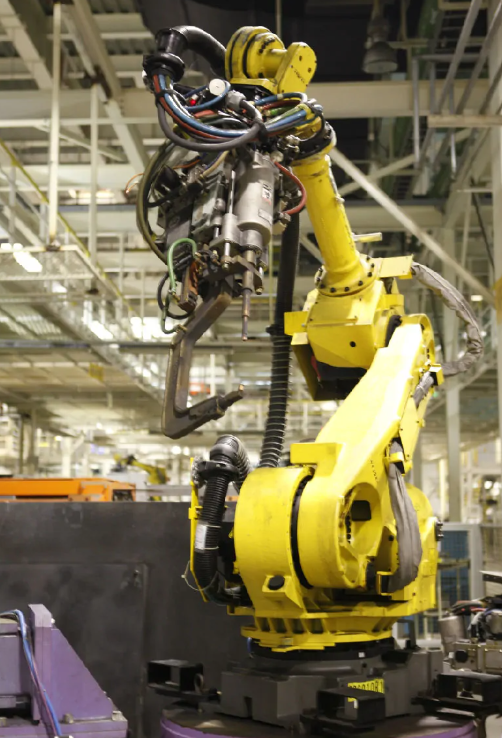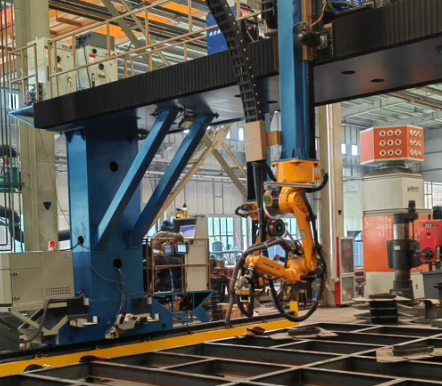Steel Box Girder (Robot Welding)
With the development of electronic technology, computer technology, numerical control and robot technology, the technology of automatic welding robot has become more and more mature since it was used in production in the 1960s. It mainly has the following advantages:
1) Stabilize and improve the welding quality, and reflect the welding quality in the form of numerical value;
2) Improve labor productivity;
3) Improve the labor intensity of workers and work in harmful environment;
4) Lower requirements for workers' operation skills;
5) It shortens the preparation cycle for product upgrading and reduces the corresponding equipment investment.
Therefore, it has been widely used in all walks of life.
Composition structure
Welding robot mainly includes robot and welding equipment. The robot is composed of the robot body and the control cabinet (hardware and software). Welding equipment, such as arc welding and spot welding, is composed of welding power supply (including its control system), wire feeder (arc welding), welding gun (clamp), etc. The intelligent robot shall also have a sensing system, such as a laser or camera sensor and its control device.
Welding robots produced all over the world are basically joint robots, most of which have six axes. Among them, axis 1, 2 and 3 can send the end tool to different spatial positions, while axis 4, 5 and 6 can meet the different requirements of tool posture. The mechanical structure of the welding robot body mainly has two forms: one is a parallelogram structure, and the other is a lateral (tilting) structure. The main advantage of the side mounted (tilting) structure is that the upper and lower arms have a large range of motion, so that the working space of the robot can almost reach a sphere. Therefore, the robot can be hung upside down on the rack to save floor space and facilitate the flow of objects on the ground. However, the 2 and 3 axes of this side mounted robot are cantilever structures, which reduces the stiffness of the robot. It is generally suitable for robots with small loads, such as arc welding, cutting or spraying. The upper arm of a parallelogram robot is driven by a pull rod. The pull rod and the lower arm form two sides of a parallelogram. Hence the name. The early developed parallelogram robot has a small workspace (limited to the front of the robot), which is difficult to work upside down. However, the new type of parallelogram robot (parallel robot) developed since the late 1980s has been able to expand the workspace to the top, back and bottom of the robot, without the stiffness problem of the measuring robot, so it has received widespread attention. This structure is suitable for both light and heavy robots. In recent years, the robots used for spot welding (with a load of 100 ~ 150kg) mostly use the parallelogram structure.
Each axis of the above two robots is in rotary motion, so the servo motor is driven by cycloidal pinwheel (RV) reducer (axis 1 ~ 3) and harmonic reducer (axis 1 ~ 6). Before the mid-1980s, DC servo motors were used for electrically driven robots. Since the late 1980s, countries have successively switched to AC servo motors. Because the AC motor has no carbon brush and good dynamic characteristics, the new robot not only has a low accident rate, but also has a large increase in maintenance free time and a fast acceleration (deceleration). For some new light robots with a load of less than 16KG, the maximum movement speed of the tool center point (TCP) can reach more than 3m/s, with accurate positioning and small vibration. At the same time, the control cabinet of the robot also uses a 32-bit microcomputer and a new algorithm, so that it has the function of self optimizing the path, and the running track is closer to the teaching track.
Characteristic
Spot welding does not require very high welding robots. Because spot welding only needs point position control, there is no strict requirement on the movement track of the welding tongs between points, which is also the reason why robots can only be used for spot welding at the earliest time. The robot for spot welding should not only have sufficient load capacity, but also have fast speed, stable action and accurate positioning when shifting between points, so as to reduce the shift time and improve work efficiency. The load capacity of the spot welding robot depends on the type of welding tongs used. For the welding tongs separated from the transformer, a robot with a load of 30 ~ 45kg is sufficient. However, on the one hand, due to the long secondary cable and large power loss, it is not conducive for the robot to extend the welding tongs into the workpiece for welding; On the other hand, the cable swings continuously with the movement of the robot, and the cable is damaged quickly. Therefore, at present, the use of integrated welding tongs is gradually increasing. The mass of this welding tongs together with the transformer is about 70kg. Considering that the robot should have enough load capacity and be able to send the welding tongs to the space position for welding with a large acceleration, the heavy robot with a load of 100 ~ 150kg is generally selected. In order to meet the requirements of short distance and rapid displacement of welding tongs during continuous spot welding. The new heavy-duty robot has the function of completing 50mm displacement within 0.3s. This puts forward higher requirements for the performance of the motor, the operation speed and algorithm of the microcomputer.
Structural design
Because the designed welding robot works in the quasi plane and narrow space environment, in order to ensure that the robot can track the weld seam automatically according to the deviation information of the arc sensor, the designed robot should be compact, flexible and stable. According to the characteristics of narrow space, a small mobile welding robot is developed. According to the motion characteristics of each structure of the robot, the modular design method is used, The robot mechanism is divided into three parts: wheeled mobile platform, welding torch adjusting mechanism and arc sensor. Among them, due to its large inertia and slow response, the wheeled mobile platform mainly tracks the weld roughly, the welding torch adjusting mechanism is responsible for the accurate tracking of the weld, and the arc sensor completes the real-time identification of the weld deviation. In addition, the robot controller and motor driver are integrated on the robot mobile platform to make it smaller. At the same time, in order to reduce the impact of dust on moving parts in harsh welding environment, a fully enclosed structure is adopted to improve the system reliability.
Equipment
The welding equipment of the spot welding robot adopts the integrated welding tongs, and the welding transformer is installed behind the welding tongs, so the transformer must be miniaturized as much as possible. For transformers with small capacity, 50Hz power frequency AC can be used. For transformers with large capacity, inverter technology has been used to change 50Hz power frequency AC to 600 ~ 700Hz AC, reducing the volume of the transformer. After voltage transformation, 600 ~ 700Hz AC can be directly used for welding, and secondary rectification can also be conducted for DC welding. Welding parameters are adjusted by timer. The new timer has been computerized, so the robot control cabinet can directly control the timer without additional interface. The welding tongs of the spot welding robot usually use pneumatic welding tongs. The opening between the two electrodes of the pneumatic welding tongs generally has only two strokes. And once the electrode pressure is set, it cannot be changed at will. In recent years, a new kind of electric servo spot welding tongs has emerged. The opening and closing of the welding tongs are driven by the servo motor and fed back by the code disk, so that the opening of the welding tongs can be arbitrarily selected and preset according to the actual needs. Moreover, the pressing force between the electrodes can also be adjusted steplessly. The new electric servo spot welding tongs have the following advantages:
1) The welding cycle of each welding spot can be greatly reduced, because the opening degree of the welding tongs is precisely controlled by the robot, and the welding tongs can start to close when the robot moves between points; After a little bit of welding, the welding tongs are opened, and the robot can move at the same time. It is not necessary to wait until the robot is in place before the welding tongs are closed or the robot moves after the welding tongs are fully opened;
2) The opening degree of the welding tongs can be adjusted arbitrarily according to the conditions of the workpiece. As long as there is no collision or interference, the opening degree shall be reduced as much as possible to save the opening degree of the welding tongs and the time occupied by the opening and closing of the welding tongs.
3) When the welding tongs are closed and pressurized, not only the pressure can be adjusted, but also the two electrodes are closed gently when they are closed to reduce impact deformation and noise.
Welding applications.

Related News
Submitted successfully
We will contact you as soon as possible


















